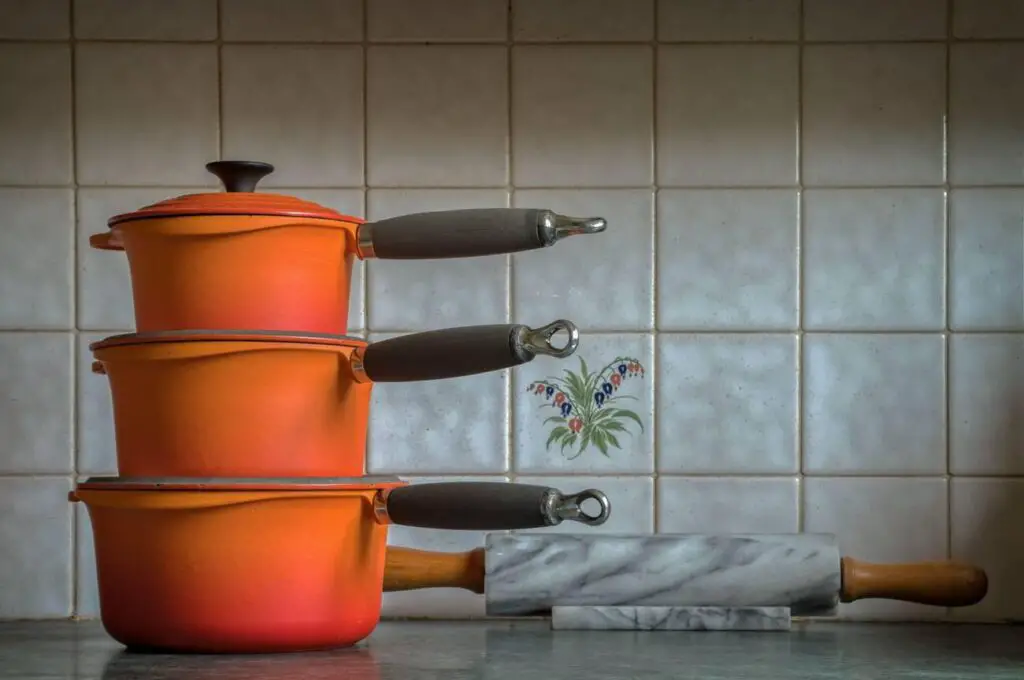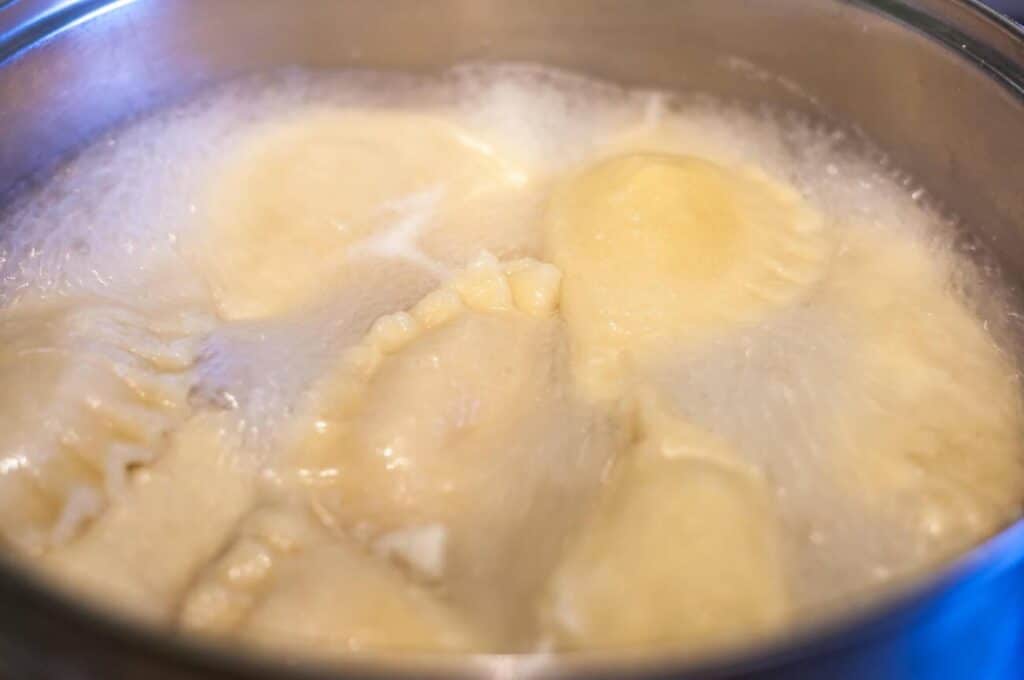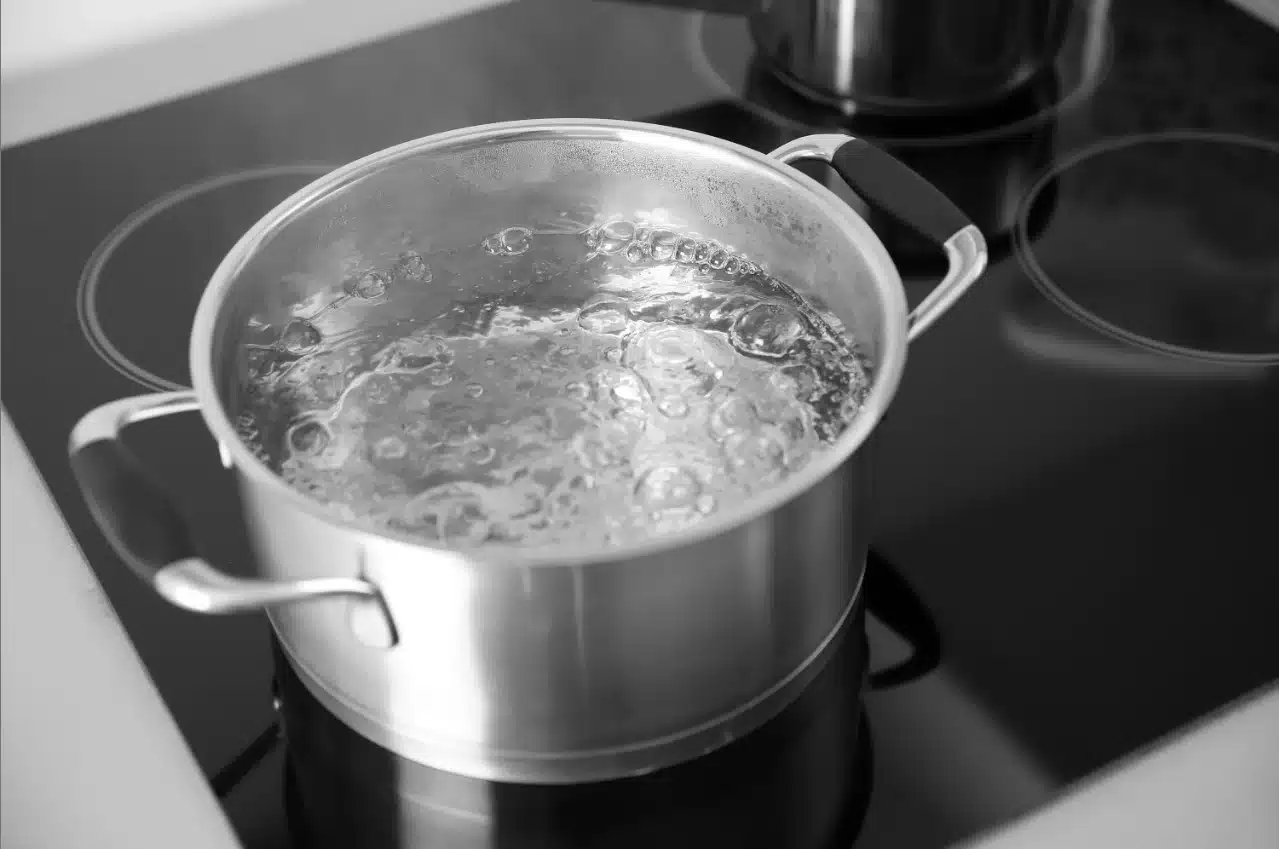Introduction
Embarking on a culinary journey requires a grasp of various cooking techniques, and understanding the concept of a rolling boil is fundamental among them. Furthermore, it’s not just a simple boil; it’s a vigorous state of boiling that ensures your food is cooked perfectly and safely. This crucial stage is integral to many cooking processes, ranging from making pasta and brewing tea to sterilizing jars for canning.
How to Achieve a Rolling Boil
Achieving a rolling_boil is a fundamental cooking skill, essential for a variety of recipes and culinary tasks. Furthermore, follow these straightforward steps and tips to ensure you successfully reach the Rolling Boil every time.
Steps to Achieve it:
-
Choose the Right Pot:
- Select a pot that is large enough to hold your liquid with some room to spare. This prevents overflow once the liquid starts boiling vigorously.
-
Fill the Pot:
- Add the required amount of liquid (usually water) to the pot. Avoid filling it to the brim to prevent spilling.
-
High Heat Setting:
- Place the pot on the stove and turn the heat to the highest setting. The high heat will cause the liquid to heat up rapidly.
-
Wait for Bubbles:
- As the liquid heats, watch for small bubbles to form at the bottom and sides of the pot. This is the initial stage of boiling.
-
Observe the Boil:
- Once the bubbles start rising to the surface and breaking, observe the intensity. the Rolling_Boil is characterized by large, rapid bubbles that continuously break the surface.
-
Adjust the Heat:
- If necessary, adjust the heat to maintain the Rolling Boil without overflowing. Some stoves may require you to lower the heat slightly to sustain the boil.
Additional Tips:
-
Use a Lid:
- Covering the pot with a lid will trap heat and help the liquid reach a boil faster. Remember to remove the lid once a boil is achieved to prevent overflow.
-
Avoid Overcrowding:
- If boiling food items, avoid overcrowding the pot as it can lower the temperature and disrupt the boil.
-
Altitude Consideration:
- Keep in mind that water boils at a lower temperature at higher altitudes. Consequently, if you live in a high-altitude area, it may take longer to achieve an Rolling_Boil.
-
Use Hot Water:
- Starting with hot water (instead of cold) will reduce the time it takes to reach a boil.
Equipment for Achieving a Perfect Rolling Boil

Disclosure: This post contains affiliate links.If you click and make a purchase, I may earn a small commission at no extra cost to you.
Achieving a perfect Rolling_Boil is not just about the technique but also about using the right equipment. Having the right tools can significantly make the process smoother, more efficient, and ultimately more successful. Furthermore, below is a list of essential equipment and their pivotal roles in achieving a perfect Rolling_Boil:
1. Heavy-Bottomed Pot:
- Purpose: Ensures even heat distribution, preventing hot spots and providing consistent heating to achieve and maintain the Rolling Boil.
- Material Options: Stainless steel, cast iron, or anodized aluminum are excellent choices.
2. Lid:
- Purpose: Helps the liquid reach a boil faster by trapping heat and steam.
- Note: Remember to remove the lid once a boil is achieved to prevent overflow and allow you to monitor the boil.
3. Heat-Resistant Spatula or Spoon:
- Purpose: Useful for stirring the liquid or food to ensure even heating and prevent sticking or burning.
4. Stove:
- Purpose: Provides the heat source necessary to achieve a rolling boil.
- Type: Both gas and electric stoves are effective, but ensure it provides consistent and adjustable heat.
5. Thermometer:
- Purpose: Allows you to monitor the temperature of the liquid to ensure it reaches and maintains the boiling point.
- Type: A clip-on candy or deep-fry thermometer is ideal.
6. Kettle (Optional):
- Purpose: Can be used to heat water quickly and efficiently before transferring it to a pot to achieve a rolling boil faster.
7. Timer:
- Purpose: Helps you monitor the boiling time, especially important for recipes that require precise boiling durations.
8. Trivet or Heat Diffuser:
- Purpose: Useful for lowering the heat and maintaining a steady boil, especially on high-powered burners.
Tips for Maintaining a Rolling Boil
Below are some practical tips to help you maintain a rolling boil effectively:
Choose the Right Cookware:
- Use a Suitable Pot: Opt for a pot that is appropriate for the amount of liquid you are boiling. It should be large enough to prevent overflow but not so large that it disperses heat inefficiently.
Regulate the Heat:
- Adjust the Heat Setting: Once a rolling boil is achieved, you may need to lower the heat slightly to maintain it without letting it overflow or cool down too much.
- Use a Burner That Fits the Pot Size: Ensure the stove burner is suitable for your pot size for even heating and effective maintenance of a rolling boil.
Use a Lid Wisely:
- Cover the Pot Initially: Use a lid to cover the pot initially to reach a boil faster, but remove it once a boil is achieved to monitor and maintain the boil effectively.
Avoid Overcrowding:
- Do Not Overcrowd the Pot: When boiling food, ensure that the pot is not overcrowded; this will allow for even heat distribution and prevent the temperature from dropping too low.
Monitor the Boil:
- Keep an Eye on the Pot: Continuously monitor the boil to ensure it is maintained; additionally, make necessary adjustments to the heat as needed.
- Look for Consistent Bubbling: Ensure that large, rapid bubbles are continuously breaking the surface, indicating a maintained rolling boil.
Consider the Liquid:
- Be Mindful of the Liquid Type: Different liquids have different boiling points. Be aware of the liquid you are boiling and adjust the heat accordingly to maintain a rolling boil.
Account for Altitude:
- Adjust for Higher Altitudes: At higher altitudes, water boils at a lower temperature; therefore, you may need to adjust the heat settings to maintain a rolling boil effectively.
Stir Occasionally:
- Stir the Liquid: Occasionally stir the liquid to ensure even heating and prevent the bottom from burning, especially when boiling thick liquids or food.
Rolling Boil and Pasta Cooking

Pasta is a staple in many cuisines, and cooking it perfectly is an art that begins with achieving a rolling boil. Furthermore, understanding the relationship between a rolling boil and pasta cooking is essential for anyone looking to master the art of pasta preparation. Now, let’s delve into the significance of a rolling boil in pasta cooking and explore some tips for perfect pasta every time.
Why is a Rolling Boil Important for Pasta Cooking?
- Ensures Even Cooking: A rolling boil is crucial in ensuring that the pasta is cooked evenly. Moreover, the vigorous boiling water keeps the pasta pieces moving, preventing them from sticking together. Consequently, this ensures that each piece is uniformly cooked.
- Improves Texture: Cooking pasta in a rolling boil helps achieve the perfect al dente texture. It ensures the pasta is cooked through but retains a slight bite, which is the desired texture for most pasta dishes.
- Enhances Flavor: A rolling boil helps in properly hydrating the pasta. As a result, it allows it to absorb water and swell, leading to enhanced flavor and the ideal consistency.
Tips for Cooking Pasta in a Rolling Boil:
-
Use a Large, Tall Pot:
- Opt for a large pot to give the pasta enough space to move, preventing clumping and sticking.
-
Salt the Water:
- Add salt to the boiling water to season the pasta as it cooks, enhancing its flavor.
-
Bring Water to a Rolling Boil:
- Ensure the water is at a rolling boil before adding the pasta for optimal cooking conditions.
-
Add Pasta Gradually:
- Add pasta gradually to ensure the water continues to boil, ensuring even cooking.
-
Stir the Pasta:
- Stir the pasta immediately after adding it to the water and occasionally during cooking to prevent sticking.
-
Follow Package Instructions:
- Adhere to the cooking time mentioned on the pasta package for the best results.
-
Test the Pasta:
- Taste the pasta towards the end of the cooking time to ensure it is cooked to the desired texture.
-
Drain Promptly:
- Once cooked, drain the pasta immediately to prevent overcooking.
Rolling Boil for Home Brewing
In the world of home brewing, achieving and maintaining a rolling boil is a critical step that significantly influences the final product. The rolling boil stage in brewing is essential for various reasons. Firstly, it plays a critical role in sterilization; moreover, it contributes significantly to flavor development. Now, let’s explore the importance of a rolling boil in home brewing and offer some valuable insights for achieving optimal brewing results.
Why is a Rolling Boil Important in Home Brewing?
- Sterilization: A rolling boil ensures that the wort (unfermented beer) is sterilized, eliminating any unwanted microorganisms that could spoil the brew.
- Hop Utilization: Secondly, the boiling process allows for the optimal extraction of bitterness, flavor, and aroma from the hops, which are a key ingredient in beer.
- Enzyme Deactivation: Additionally, a rolling boil plays a vital role in deactivating enzymes in the wort. This action halts the conversion of starches to sugars, ultimately setting the final sugar profile for fermentation.
- Protein Coagulation: Furthermore, boiling helps in coagulating unwanted proteins. This coagulation allows them to settle out, resulting in a clearer beer.
- Flavor Development: The Maillard reactions that occur during boiling contribute to the development of complex flavors and aromas in the beer.
- Evaporation: Boiling allows unwanted volatile compounds to evaporate, improving the taste and smell of the beer.
Tips for Achieving a Rolling Boil in Home Brewing:
-
Use a Suitable Brew Kettle:
- Choose a brew kettle that is large enough to hold the wort with ample space to prevent overflow during the boil.
-
Ensure Consistent Heat:
- Use a reliable heat source that can maintain a consistent rolling boil for the required duration effectively.
-
Monitor the Boil:
- Keep a close eye on the boil to ensure it is maintained and make adjustments as needed.
-
Add Hops at the Right Time:
- Add hops according to the recipe schedule to achieve the desired bitterness, flavor, and aroma.
-
Avoid a Boil Over:
- Monitor the heat and use a spray bottle with water to tame the foam and prevent a boil over.
-
Use a Thermometer:
- Utilize a thermometer to monitor the temperature and ensure it is in the right range for boiling.
How to Cool Down After Achieving a Rolling Boil
It’s essential to cool down the liquid efficiently and safely in order to proceed with the recipe or to store the liquid. Therefore, here’s a guide on how to effectively cool down:
Why is Proper Cooling Important?
- Prevents Overcooking: Efficient cooling prevents further cooking, ensuring the food retains its desired texture and flavor.
- Ensures Food Safety: Rapid cooling, in turn, minimizes the time food spends in the temperature danger zone, thereby reducing the risk of bacterial growth.
- Preserves Nutrients: Quick cooling helps in preserving the nutritional value of the food.
Methods to Cool Down After a Rolling Boil:
-
Ice Bath:
- How: Place the pot in a sink or larger container filled with ice and water.
- When to Use: Ideal for cooling small quantities of liquid or food quickly.
- Benefits: Provides rapid, even cooling.
-
Cold Water Bath:
- How: Similar to an ice bath, but uses cold water instead of ice.
- When to Use: Suitable for cooling broths, soups, or blanched vegetables.
- Benefits: Efficient cooling without the need for ice.
-
Stirring:
- How: Continuously stir the liquid or food to release heat.
- When to Use: Useful for sauces, soups, and other liquid-based foods.
- Benefits: Simple and effective, no additional equipment needed.
-
Dividing the Quantity:
- How: Divide the hot liquid or food into smaller, shallow containers.
- When to Use: Perfect for large quantities of food or liquid.
- Benefits: Speeds up the cooling process by increasing surface area.
-
Room Temperature Cooling:
- How: Allow the pot to sit uncovered at room temperature.
- When to Use: Suitable for foods that do not require rapid cooling.
- Benefits: Gradual cooling, minimal effort required.
-
Refrigeration:
- How: Place the food or liquid in the refrigerator.
- When to Use: Ideal for foods that will be stored for later use.
- Benefits: Ensures safe cooling and storage.
Additional Tips:
- Use a Thermometer: Monitor the temperature carefully to ensure that the liquid or food cools down to a safe temperature.
- Avoid Crowding the Refrigerator: Ensure adequate air circulation in the refrigerator for efficient cooling.
- Stir Occasionally: Stir the food or liquid occasionally to ensure even cooling.
Rolling Boil for Sterilization Purposes

Sterilization is a crucial process in various fields, ranging from cooking and brewing to medical and laboratory settings. Furthermore, one of the most effective and accessible methods of sterilization is using a rolling boil.
Why is a Rolling Boil Effective for Sterilization?
- High Temperature: A rolling boil reaches a temperature of 212°F (100°C) at sea level; consequently, this effectively kills most bacteria, viruses, and other pathogens.
- Accessibility: It requires only water and a heat source, thus making it an accessible and cost-effective sterilization method.
- Non-Toxic: Moreover, it does not involve the use of chemicals, ensuring that the items sterilized are safe for use without the need for rinsing.
Applications of Rolling Boil for Sterilization:
-
Kitchen Utensils:
- How: Submerge utensils in water and bring to a rolling boil for at least 10 minutes.
- Purpose: Additionally, it ensures that utensils are free from harmful microorganisms, thereby enhancing food safety.
-
Canning Equipment:
- How: Place canning jars, lids, and other equipment in water, and then boil them for 10-15 minutes.
- Purpose: Sterilization effectively sterilizes equipment for safe food preservation, thereby preventing spoilage and reducing the risk of foodborne illnesses.
-
Baby Bottles:
- How: Disassemble baby bottles and submerge all parts in water, boiling for 5-10 minutes.
- Purpose: Ensures baby bottles are sterilized, promoting infant health and safety.
-
Medical Instruments:
- How: Place medical instruments in water and boil for at least 20 minutes.
- Purpose: Sterilizes instruments for safe medical procedures, reducing the risk of infection.
-
Water Purification:
- How: Bring water to a rolling boil and maintain it for at least 1 minute (3 minutes at higher altitudes).
- Purpose: Makes water safe for drinking, especially in emergency situations or areas with questionable water quality.
Steps for Effective Sterilization Using a Rolling Boil:
-
Clean Items:
- Before sterilization, thoroughly clean the items to be sterilized to remove any dirt or debris.
-
Submerge in Water:
- Completely submerge the items in ample water in a suitable pot.
-
Bring to a Rolling Boil:
- Heat the water to a rolling boil.
-
Maintain the Boil:
- Keep the items submerged in the rolling boil for the recommended time based on the item type.
-
Carefully Remove Items:
- Use tongs or similar tools to carefully remove items from the boiling water.
-
Allow to Dry:
- Let the items air dry on a clean, dry surface.
Conclusion:
In essence, a rolling boil is a vigorous state of boiling that is crucial for various cooking and sterilization processes. Understanding the difference between a simple boil and a rolling boil, and knowing when and how to achieve it, is fundamental for successful culinary and scientific endeavors. The term “rolling boil” is the accurate term to use, reflecting the turbulent and rolling appearance of the liquid at this boiling stage.
FAQs
What is a Rolling Boil?
A rolling boil is the highest level of boiling. Moreover, in this state, the liquid is heated to a point where it vigorously bubbles and steams, creating continuous, large, and rapid bubbles that stir the liquid, ensuring even heat distribution.
Difference Between a Boil and a Rolling Boil?
- Boil: A boil is the stage where the liquid gets heated, and bubbles start forming, thus indicating the conversion of the liquid into vapor. However, the bubbles might be small, and the boiling can be gentle.
- Rolling Boil: A rolling boil is a more intense and advanced stage of boiling. At this stage, the liquid is bubbling rapidly, and the surface is in turbulent motion. Additionally, it’s the point where the entire liquid is at its boiling point.
Why is it Called a Rolling Boil?
It is called a rolling boil because of the rolling or tumbling appearance of the liquid’s surface during this intense boiling stage. The large and vigorous bubbles that continuously form and collapse give the liquid a rolling or churning appearance, hence the name.
Is it Roiling or Rolling Boil?
The correct term is “rolling boil.” The term “roiling” is sometimes mistakenly used, but “roiling” generally refers to something being agitated or stirred up, and it’s not the standard term used in cooking or other contexts to describe the boiling state.





[…] ingredients are at the right temperature. For instance, when boiling any ingredient, achieving a rolling boil is crucial to ensure even […]
[…] the perfect chocolate chip cookie often starts with the right baking temperature. A rolling boil technique can be used in some recipes to ensure the sugar and butter blend […]
[…] don’t clump together. This process is similar to the one used when bringing water to a rolling boil for cooking […]
[…] making palenta, it’s essential to bring the water to a rolling boil to ensure even cooking of the cornmeal. The dish pairs well with various accompaniments, such as […]
[…] you’re curious about other unique culinary techniques, learn about the rolling boil method and how it’s different from a regular […]
[…] ability to surprise and enchant us, much like the intricacies of achieving the perfect rolling boil in […]
[…] those interested in diving deeper into the world of boiling, rolling boil is an intriguing topic to explore. It provides insights into the bubbling world of boiling and its […]
[…] them to tamales. However, their unique taste sets them apart. Just like the difference between a rolling boil and a simmer, corundas have their distinct characteristics that make them stand […]
[…] the various cooking techniques in Mexican cuisine, you might want to dive into the concept of a rolling boil. Interestingly, chefs use this method frequently to prepare a range of dishes, including […]
[…] the nuances of ‘rolling boil appearance’, its significance in culinary arts, and how to recognize it with ease. When it […]
[…] If you’re keen on exploring more culinary terms and techniques, you might find the article on rolling boil […]